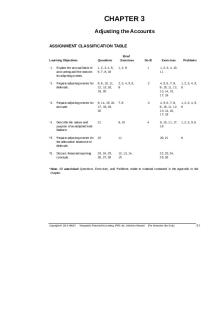05 - Seasonality and Associative Forecasting Techniques (Ch03) - Q&A PDF

| Title | 05 - Seasonality and Associative Forecasting Techniques (Ch03) - Q&A |
|---|---|
| Course | Operations Management |
| Institution | Arab Academy for Science, Technology & Maritime Transport |
| Pages | 6 |
| File Size | 296.2 KB |
| File Type | |
| Total Downloads | 117 |
| Total Views | 149 |
Summary
Book Name: Operations Management - Stevenson - 11th Edition
Chapter 3 (Forecasting)
Materials Type: Practice...
Description
Seasonality and Associative Forecasting Techniques DR. ALY ELSHEKH
Seasonality and Associative Forecasting 2021 Techniques 1. Essay Questions Define the following terms:
Predictor Variables. Seasonality. Seasonal Relatives.
Predictor variables Variables that can be used to predict values of the variable of interest. ……………………………………………………………………………………………………………… Seasonality in time-series data are regularly repeating upward or downward movements in series values that can be tied to recurring events. Examples Sales of winter and summer sports equipment Vacations or holidays (e.g., airline travel, greeting card sales, visitors at tourist and resort centers). ……………………………………………………………………………………………………………… Seasonal Relatives Also known as seasonal indexes. It is defined as percentage of average or trend. Examples Suppose that the seasonal relative for the quantity of toys sold in May at a store is 1.20. This indicates that toy sales for that month are 20 percent above the monthly average. A seasonal relative of .90 for July indicates that July sales are 10 percent less than the monthly average. ………………………………………………………………………………………………………………
1
Seasonality and Associative Forecasting 2021 Techniques
2. True / False Questions Question
T/F
1. Time series techniques involve identification of explanatory variables that can be used to predict future demand.
F
Associate forecasts involve identifying explanatory variables.
2. Forecasts based on time series (historical) data are referred to as associative forecasts.
F
Forecasts based on time series data are referred to as time-series forecasts.
3. A seasonal relative (or seasonal indexes) is expressed as a percentage of average or trend.
T
4. Removing the seasonal component from a data series (de-seasonalizing) can be accomplished by dividing each data point by its appropriate seasonal relative.
T
5. Seasonal relatives can be used to deseasonalize data or incorporate seasonality in a forecast.
T
6. Regression analysis is an associative forecasting technique.
T
7. The predictor variable in simple linear regression is also known as the dependent variable
F
2
Explanation
Seasonal relatives are used to deseasonalize data to forecast future values of the underlying trend, and they are also used to re-seasonalize deseasonalized forecasts.
Predictor variable = Independent variable
Seasonality and Associative Forecasting 2021 Techniques 3. Problems Problem 1: The following table shows the quarterly sales of a company for the current year. Quarter relatives are SR1 = 1.10, SR2 = 0.99, SR3 = 0.90, and SR4 = 1.01. Deseasonalize the sales.
Solution: Deseasonalize the values, where: Deseasonalized sales = Deseasonalized sales Q1 = Deseasonalized sales Q2 = Deseasonalized sales Q3 = Deseasonalized sales Q4 =
Actual Sales Seasonal Relative 88 = 80 1.1 99 = 100 0.99 108 = 120 0.9 141.4 = 140 1.01
There is a trend of +20 from previous quarter, hence the trend forecast would be 160 units. Multiplying the trend forecast by the seasonal relative for quarter 1 yields a forecast for the next quarter: T*S = (140 + 20) x (1.1) = 176.
…………………………………………………………………………………………...... Problem 2: New car sales for a dealer for the past six months are shown in the following table, along with monthly indexes (seasonal relatives), which are supplied to the dealer by the regional distributor. Deseasonalize car sales.
3
Seasonality and Associative Forecasting 2021 Techniques
Solution: Deseasonalized sales =
Actual Sales Seasonal Relative
…………………………………………………………………………………………...... Problem 3: The sales of a furniture manufacturer for the past 4 quarters are shown in the following table. Quarter relatives are SR 1 = 1.20, SR 2 = 1.10, SR 3 = 0.75, and SR 4 =0.95. Use this information to deseasonalize sales.
4
Seasonality and Associative Forecasting 2021 Techniques
Solution: Deseasonalized sales =
Actual Sales Seasonal Relative
…………………………………………………………………………………………......
5...
Similar Free PDFs

Forecasting
- 6 Pages

Ch03 - Cells and Tissues
- 24 Pages

Ch03
- 71 Pages

PERT AND CPM Techniques
- 66 Pages

Coaching Model and Techniques
- 5 Pages

Growth and Development CH03 TB
- 41 Pages

COUNSELING SKILLS AND TECHNIQUES
- 7 Pages

QA Installment Sales
- 3 Pages
Popular Institutions
- Tinajero National High School - Annex
- Politeknik Caltex Riau
- Yokohama City University
- SGT University
- University of Al-Qadisiyah
- Divine Word College of Vigan
- Techniek College Rotterdam
- Universidade de Santiago
- Universiti Teknologi MARA Cawangan Johor Kampus Pasir Gudang
- Poltekkes Kemenkes Yogyakarta
- Baguio City National High School
- Colegio san marcos
- preparatoria uno
- Centro de Bachillerato Tecnológico Industrial y de Servicios No. 107
- Dalian Maritime University
- Quang Trung Secondary School
- Colegio Tecnológico en Informática
- Corporación Regional de Educación Superior
- Grupo CEDVA
- Dar Al Uloom University
- Centro de Estudios Preuniversitarios de la Universidad Nacional de Ingeniería
- 上智大学
- Aakash International School, Nuna Majara
- San Felipe Neri Catholic School
- Kang Chiao International School - New Taipei City
- Misamis Occidental National High School
- Institución Educativa Escuela Normal Juan Ladrilleros
- Kolehiyo ng Pantukan
- Batanes State College
- Instituto Continental
- Sekolah Menengah Kejuruan Kesehatan Kaltara (Tarakan)
- Colegio de La Inmaculada Concepcion - Cebu







